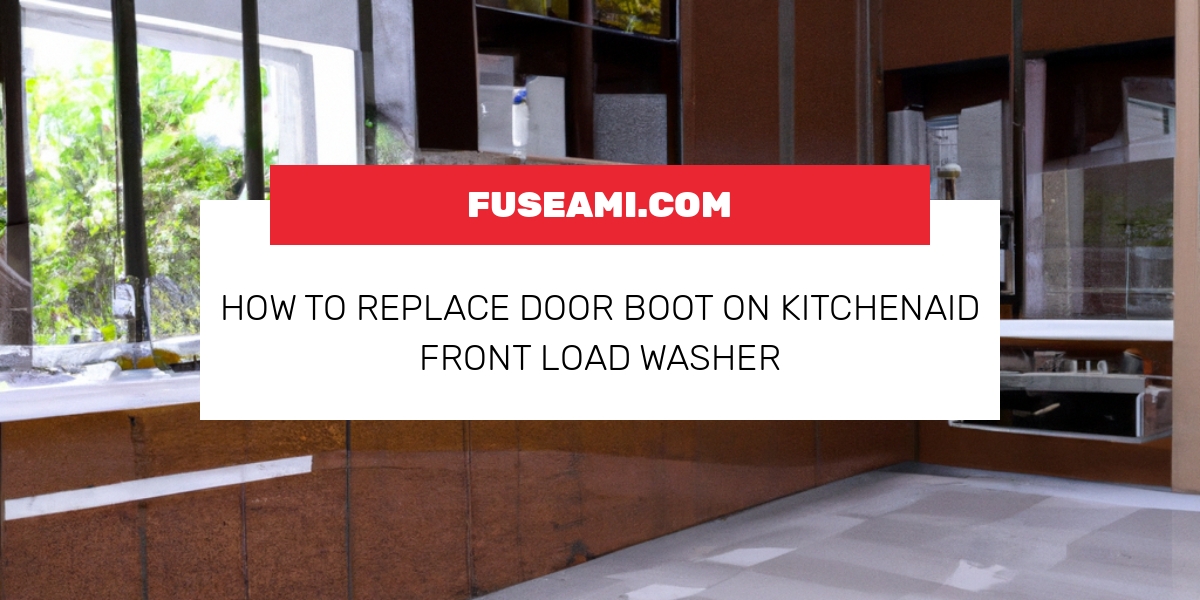This KitchenAid washer repair guide provides instructions on how to replace the boot seal made of rubber on front load KitchenAid washer. The rubber seal is an elastic gasket that is placed between the drum and the door that stops leaks. Inspect the rubber door boot seal to check whether the washer has started to leak through the front panel. If you find that the KitchenAid washer door boot is damaged, replace it with a manufacturer-approved washer part. Turn off the power: Unplug the power cord from the wall outlet. Protect your hands with work gloves. Have someone help you move the washer away from the wall. Take the top panel out. Pull the top panel toward the rear of the washer. Then, lift it up and off.
Take off the control panel: Unscrew the screw on the left back of the control panel. Moving the drawer of the dispenser forward, until it comes to a stop. The locking tab at the back is released. The drawer is pulled from its housing. Take off the screws on each side of the dispenser housing. Unplug the wire harness connectors to the control panel by pressing on the release tabs and then sliding the connectors off. To remove the top, place yourself before the washer. Pull the control panel off the KitchenAid washer.
Remove the front panel: Lift the drain filter cover at the lower part of the front panel. Take off the screw that holds the plastic housing for the pump to the frame of the KitchenAid washer. The plastic housing of the pump must be removed. Remove the mounting screw from the bottom of the front panel. Unlock the KitchenAid washer door. Utilize the spring clamps on the outside to extend the spring clamp before removing it from the door boot. The door boot’s rubber part should be removed from the lip on the top of the washer tub opening on the front of the panel. Remove the 7 screws from the top of the front panel. Close the KitchenAid door for the washer. Tip the top of the front panel to the side and remove the wire harness from the door lock/switch.
Remove the washer from the front panel: Remove the counterbalance weights. Remove the bolts from the bottom counterbalance weight and pull bottom counterbalance weight out of the tub. Repeat the procedure to take off the top counterbalance weight.
Remove the door boot: Use pliers to release the spring clamps, then pull the hoses away from the door boot. Unlock the tab, then disconnect the wire harness to the light on the drum. The spring tool inside can be used to release the spring clamp. Pull the door boot off the tub. Install the new boot. The new door boot should be placed on the front of the tub with the arrow tab located at the top of the door boot around 12 hours. Be sure that the hoses are aligned correctly. The door boot should be inserted into the tub’s lip, making sure that you properly place it over the entire tub. Around 12 o’clock, place the spring clamp on the lip. The spring pliers on the inside can be used for expanding the spring clamp. Plug the harness for the drum light back into.
Make sure the locking tab is secured: Attach the hoses to the door boot connections. Fix them with spring clamps. To prevent rubbing, leave enough space between spring clamps and the door boot.
Reinstall the counterbalance weighs: Reinstall the counterbalance weight on the lower part of the tub by using the bolts to mount. Follow the steps to install the top counterbalance weight.
Install the front washer panel: Position the front panel on top of the cabinet. Connect the door switch wiring harness. Place the front panel on the frame, and line up the mounting screw holes on the top of the front panel. Attach the 7 mounting screws on the top of the front panel. Then tighten them. Open the KitchenAid washer doors. Place the door boot correctly to fit around the edge of the opening in the front door panel. The spring clamp will hold the door boot. The screw is inserted into lower part of the KitchenAid washer in the hole for the pump housing. Then tighten. The drain pump’s filter housing is to be pushed into recess on the bottom of the washer. Install the mounting screws, then secure it. Close the drain pump filter doors to the housing.
Install the control panel: Place the control panel to the top of the front panel. Install the screws back into the dispenser housing. Screws should be installed at the rear right of the control panel. Attach the wiring harness to the control panel. Push the detergent dispenser back to the drawer’s base. Install the top panel by pushing it forward and downwards to secure it to the frame of the washer. Reinstall the screws to anchor the back panel. Do not tighten too much. To restore power, plug the KitchenAid washer into an electrical outlet. Then, the washer is returned to its original position.
While replacing the door boot of KitchenAid’s front-load washer might seem daunting, with the right tools, it is possible to perform the task swiftly and without difficulty. Through identifying and diagnosing what is causing the problem it will save you money for costly repairs and prolong the lifespan of your KitchenAid washing machine. Regular maintenance, including cleaning the seal on your door, and making sure there are no cracks or damage, can prevent problems from occurring and ensure maximum performance.



